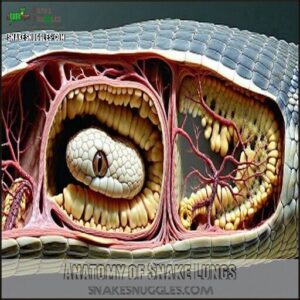This site is supported by our readers. We may earn a commission, at no cost to you, if you purchase through links.

Most snakes have one elongated lung that helps them efficiently pull in oxygen using powerful rib muscles.
They’ll use their flexible windpipe and specialized nostrils to breathe on land, with their glottis acting like a built-in snorkel.
Some aquatic snake species can even absorb oxygen through their skin underwater, which is a pretty cool survival trick.
Their breathing mechanism allows them to take in air while swallowing prey, thanks to a movable windpipe that keeps air flowing.
Want to unravel more about these slithery breathers’ secret respiratory strategies?
Table Of Contents
- Key Takeaways
- How Do Snake Lungs Work?
- How Do Snakes Breathe on Land?
- How Do Snakes Breathe Underwater?
- How Do Snakes Breathe While Eating?
- Do Snakes Breathe With Lungs or Gills?
- What Breathing Equipment Do Snakes Have?
- Exhaling on How Snakes Breathe
- Frequently Asked Questions (FAQs)
- How do snakes breathe?
- How to handle a fire-breathing snake?
- Do snakes have a respiratory system?
- Do snakes need a diaphragm to breathe?
- Do snakes breathe with lungs or gills?
- What does snake breathing look like?
- How long can a snake hold its breath?
- Do snakes breathe air or water?
- Can snakes breathe through their skin?
- How long can snakes hold their breath?
- Conclusion
Key Takeaways
- You’ll discover that snakes breathe through a single, elongated lung, using specialized rib muscles to expand and contract their respiratory system with remarkable efficiency.
- Unlike mammals, snakes don’t need a diaphragm; they’ve evolved a unique breathing mechanism that allows them to take in oxygen while swallowing prey, even underwater.
- You’ll be amazed that some aquatic snake species can absorb oxygen through their skin, complementing their lung-based respiration and enabling them to survive in diverse environments.
- Snakes’ respiratory system is a marvel of adaptation, featuring a flexible glottis, movable windpipe, and asymmetrical lung structure that lets them breathe effectively in tight spaces and during complex physical movements.
How Do Snake Lungs Work?
Have you ever wondered how snakes manage to breathe with their unique, elongated body structure?
You’ll be surprised to learn that snakes possess a fascinating respiratory system where a single, specialized lung and an intricate network of muscular ribs work together to guarantee efficient oxygen intake and carbon dioxide expulsion.
Anatomy of Snake Lungs
Diving into the fascinating world of snake lung anatomy reveals a unique respiratory design that’s both efficient and compact.
Snakes boast an asymmetrical lung structure that sets them apart from other vertebrates.
Their lung morphology highlights nature’s ingenious adaptations:
- A well-developed right lung dominates the respiratory system
- A smaller, vestigial left lung conserves body space
- Highly vascularized lung tissue maximizes oxygen exchange
- Specialized air sacs support flexible breathing mechanisms
This remarkable lung structure allows snakes to thrive in diverse environments, showcasing the incredible adaptability of snake respiration.
Some aquatic snakes even exhibit cutaneous respiration adaptations, absorbing oxygen through their skin.
Modular Lung Ventilation
Have you ever wondered how snakes breathe when their bodies are twisted?
Modular lung ventilation is a remarkable adaptation that lets snakes control their breathing with incredible precision.
Through selective rib muscle control, they can create unidirectional airflow, enabling them to absorb oxygen efficiently even when constricting prey.
This evolutionary marvel guarantees survival in challenging situations.
Some aquatic snakes even use cutaneous respiration to supplement oxygen intake.
How Do Snakes Breathe on Land?
You’ve likely wondered how snakes manage to breathe without the diaphragm muscles we humans rely on.
On land, snakes use their remarkable rib muscles to expand and contract their body, drawing air into their elongated lungs through a complex but efficient breathing mechanism.
Rib Contraction and Inhalation
As snake lungs prepare to welcome fresh air, their incredible breathing mechanism springs into action.
Slithery breathers orchestrate a magnificent respiratory dance with ingenious muscular precision.
Your slithery friends use intercostal muscles to create a precise ribcage expansion, pulling ribs outward like an accordion. These strategic rib contractions generate a powerful vacuum, drawing oxygen deep into their lungs.
Nerve impulses choreograph this complex lung ventilation dance, allowing snakes to breathe with remarkable efficiency. Boa constrictors especially showcase this skill, controlling specific rib movements to guarantee continuous breathing even while capturing prey.
Snakes also possess specialized nostril valves to safeguard water entry.
Exhalation Process
After inhaling, a snake’s rib muscles relax, triggering lung deflation like a collapsing balloon.
The glottis opens, allowing carbon dioxide to escape through a precise breathing mechanism.
Muscle coordination helps expel air using buccal pumping, where reptile breathing involves strategic skin and nose valve movements.
Each breath showcases the marvel of snake respiration, turning a simple exhale into an intricate dance of biological efficiency.
How Do Snakes Breathe Underwater?
Most aquatic snakes can master underwater breathing through remarkable adaptations.
These reptilian divers employ ingenious survival techniques to thrive beneath the waves:
- Lung Capacity: Store massive air volumes for extended underwater exploration
- Metabolic Magic: Dramatically reduce oxygen consumption during submersion
- Skin Breathing: Absorb dissolved gases through specialized cutaneous respiration
- Nostril Protection: Seal valves prevent water entry during submersion
Underwater, sea snakes showcase extraordinary apnea durations, holding their breath for impressive periods while traversing marine environments with evolutionary precision.
How Do Snakes Breathe While Eating?
Ever wondered how snakes manage to breathe while swallowing prey whole?
Their remarkable respiratory system allows them to shift their glottis and extend their trachea, creating an ingenious airway that keeps them breathing even as they consume massive meals.
Constrictor Rib Muscles
When constricting prey, boa constrictors showcase remarkable muscle specialization through localized lung ventilation.
Their evolutionary breathing mechanisms allow unidirectional airflow by strategically engaging specific rib muscles.
This incredible adaptation guarantees continuous respiration during constriction, letting these predators maintain oxygen intake while immobilizing their meal with powerful, precise rib control.
Swallowing Facilitation
When swallowing prey, snakes employ a remarkable respiratory strategy that defies biological limits.
Their constrictor rib muscles orchestrate a complex dance of survival, enabling them to manage breathing during feeding through precise muscular coordination.
They can effectively navigate potential challenges by:
- Displacing the trachea to create prey passage
- Maintaining respiratory functionality
- Coordinating rib movements without respiratory interruption
This ingenious adaptation allows snakes to consume large prey quickly, ensuring their breathing remains uncompromised during the most vulnerable moments of their feeding process.
Snakes also utilize selective rib movement to minimize muscular effort during breathing.
Do Snakes Breathe With Lungs or Gills?
After mastering the art of breathing while consuming prey, you might wonder: do snakes breathe with lungs or gills?
Just like most reptiles, snakes are lung-breathing champions, not aquatic gill-users. Their snake lungs represent an evolutionary marvel of oxygen absorption across diverse environments.
Unlike fish that extract oxygen through gill membranes, snakes leverage cutaneous respiration and specialized lung adaptations.
Some aquatic snake species can even absorb oxygen through their skin, a demonstration of their remarkable respiratory system’s flexibility.
Their snake respiratory system allows them to thrive on land and occasionally underwater, showcasing nature’s innovative design.
These lung-based breathing mechanisms reflect snake evolution’s incredible capacity to adapt, surviving where other creatures might struggle. Their respiratory prowess is nothing short of biological engineering.
What Breathing Equipment Do Snakes Have?
You might be surprised to learn that snakes have a remarkable respiratory system that’s quite different from other animals.
Their breathing equipment includes a unique combination of nostrils, a flexible glottis, an elongated trachea, and an asymmetrical lung that allows them to survive in diverse environments.
Nose
Ever wondered how a snake breathes through its nose?
Your slithery friend’s nostrils at the snout tip are more than just air passages.
With specialized nostril valves, these fascinating organs seal during underwater adventures, enabling short-term submersion.
Beyond air intake, their nostrils support mucus production and sensory reception, showcasing nature’s clever design for survival.
Their internal nasal structure facilitates these functions.
These tiny openings are a snake’s gateway to respiratory magic, adapting to land and water with remarkable precision.
Glottis
Regarding snake breathing, the glottis is a marvel of biological engineering.
This tiny, slit-like opening at the back of a snake’s mouth acts as a precise airflow control mechanism.
- Imagine a muscular gateway that rhythmically opens and closes, protecting the tracheal entrance with remarkable efficiency.
The glottis is more than just a breathing valve—it’s a adaptation that allows snakes to perform complex respiratory maneuvers.
By shifting and adjusting, this flexible structure enables snakes to breathe while swallowing prey, showcasing nature’s ingenious design for survival.
Some owners even purchase specialized feeding tools to assist with this process.
Its evolution represents an affirmation to the incredible adaptability of these remarkable reptiles.
Trachea
Right after the glottis, the snake’s trachea emerges as a remarkable breathing highway.
Reinforced by sturdy cartilage rings, this flexible windpipe prevents collapse during respiration, ensuring uninterrupted airflow.
Its unique anatomy allows remarkable breathing adaptations that support the snake’s survival.
| Feature | Function | Significance |
|---|---|---|
| Cartilage Rings | Structural Support | Prevents Airway Collapse |
| Flexible Design | Air Passage | Enables Efficient Breathing |
| Strategic Position | Oxygen Conduit | Connects Mouth to Lungs |
The tracheal lung’s ingenious design lets snakes breathe through tight spaces, showcasing nature’s incredible engineering.
Lungs
Diving into snake lung anatomy reveals a fascinating world of respiratory adaptation.
Most snakes boast a single, elongated lung with an ingenious design: the anterior section handles gas exchange, while the posterior acts as a powerful air pump.
This unique tracheal lung structure enables modular ventilation, allowing snakes to breathe efficiently even while constricting prey or swallowing massive meals.
Their lung evolution showcases a remarkable physiological innovation that’s been integral to snakes’ incredible ecological success, highlighting how these reptiles have optimized breathing through millions of years of adaptation.
Exhaling on How Snakes Breathe
Now that you’ve explored the snake’s breathing arsenal, let’s crack open the secrets of exhaling!
Snakes master lung deflation through a symphony of muscular effort and precise breathing mechanisms.
Their unique respiratory system relies on:
- Rib relaxation to shrink the chest cavity
- Glottis opening for smooth air expulsion
- Trachea guiding breath out effortlessly
Interestingly, some resources offer products for snakes.
By strategically controlling their lungs and trachea, these slithery scientists make breathing look like an art form.
Each exhale tells a story of evolutionary brilliance, transforming simple breath into a survival masterpiece.
Frequently Asked Questions (FAQs)
How do snakes breathe?
Slithering, stretching, surviving—snakes breathe through a unique respiratory system.
You’ll find they use rib muscles and a flexible trachea to draw air into their elongated lungs, adapting brilliantly to their serpentine anatomy with remarkable efficiency.
How to handle a fire-breathing snake?
You’ll need a fire extinguisher, protective gear, and professional help.
Don’t attempt to handle a fire-breathing snake alone.
Call wildlife experts immediately for safe containment and removal of this incredibly rare and dangerous creature.
Do snakes have a respiratory system?
Picture a hidden highway of life pulsing through a serpent’s body.
Yes, snakes boast a sophisticated respiratory system with lungs, trachea, and specialized breathing mechanisms that keep them alive and kicking, slithering through diverse environments.
Do snakes need a diaphragm to breathe?
You don’t need a diaphragm to breathe like mammals do.
Snakes use their flexible rib muscles to expand and contract their lungs, drawing air in and out through an ingenious, muscle-driven respiratory mechanism.
Do snakes breathe with lungs or gills?
Snakes exclusively use lungs for breathing, not gills.
You’ll find their unique respiratory system stretches along their body, with most species relying on a single, elongated lung to extract oxygen efficiently from the air. Efficiently from the air.
What does snake breathing look like?
Did you know snakes use just one lung?
You’ll witness their breathing through body-wide rib movements, with their flexible trachea extending during meals, allowing oxygen intake even while swallowing large prey. You’ll witness
How long can a snake hold its breath?
You’ll be amazed that underwater serpents can hold their breath for an impressive two hours!
Their remarkable lung adaptations and metabolic control allow them to survive extended periods without surfacing, depending on water temperature and activity level.
Do snakes breathe air or water?
You’ll find snakes primarily breathe air through their lungs, using a specialized respiratory system.
They can absorb oxygen underwater through skin respiration, but they aren’t aquatic breathers and must surface regularly to inhale oxygen.
Can snakes breathe through their skin?
Like a living sponge absorbing secrets, some water-dwelling snakes can indeed breathe through their skin.
Performing a subtle underwater dance of gas exchange when oxygen levels are low and survival demands creativity.
How long can snakes hold their breath?
You’ll be surprised that snakes can hold their breath for minutes to hours, depending on species, water temperature, and activity level.
Some aquatic snakes can stay underwater for up to two hours without taking a breath.
Conclusion
Breathing like a serpent reveals nature’s remarkable design – how snakes breathe reveals an extraordinary adaptation of survival.
You’ll marvel at their unique respiratory mechanisms, from elongated lungs to flexible windpipes that enable incredible oxygen absorption.
Whether slithering on land or gliding underwater, these remarkable creatures have perfected breathing strategies that challenge our understanding of respiratory systems.
Plunge into how snakes breathe, and you’ll discover a tribute to evolutionary ingenuity.
- https://journals.physiology.org/doi/abs/10.1152/jappl.1991.71.6.2304
- https://link.springer.com/article/10.1007/BF00388513
- https://www.adelaide.edu.au/research/news/list/2019/09/04/deep-breath-this-sea-snake-gathers-oxygen-through-its-forehead
- https://www.ncbi.nlm.nih.gov/pmc/articles/PMC6514467/
- https://www.australiangeographic.com.au/news/2021/04/why-do-snakes-yawn/















